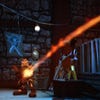Medieval Moves Review
Horrible histories?
The paradox of motion gaming is that as the technology frees the player from the tyranny of buttons and sticks, it constricts the developer in terms of what can realistically be done on-screen. Between the binary comfort of a button press and the thousands of incremental movements of the human body, there's a chasm where accepted game design ideas are easily lost.
That's why so many motion-controlled games are so simple. Better to let the player do one thing with reasonable consistency than push the boundaries and leave them flailing hopelessly in a quagmire of living-room embarrassment.
Medieval Moves, a budget release from Sports Champions developer Zindagi Games, plays it very safe indeed. In fact, its two most heavily used gameplay components have been lifted wholesale from Sports Champions and dressed up in fantasy clothing.
You're playing as Prince Edmund, an aspiring young knight who becomes the kingdom's only hope when the necromancer Morgrimm takes over, transforming everyone - including Edmund - into skeletons. Morgrimm also steals the vital gatestone, splits it into convenient pieces and leaves them at the end of each level.
Medieval Moves (sadly no relation to Sony's Medievil series, despite the similar title and skeletal hero) avoids the question of navigation by placing you firmly on rails. Edmund, or Deadmund as his bony form is known, jogs along through Fable-esque scenery, then stops as enemies approach. You defend by raising your shield, and can smash them away with a wave of your sword or pick them off with your bow and arrow. As you progress you gain additional weapons, such as throwing stars and dynamite, as well as a grapple hook used to swing at scripted points. It's a small but useful arsenal, though the vast bulk of the game is made up of the tried and trusted slash-and-shoot stuff.
These elements work well enough, as you'd hope given that they're essentially the archery and gladiator events from Sports Champions repackaged with a swords-and-sorcery makeover. Play with one Move controller and it becomes a bit of a fumble juggling all the different defence and combat options. Two Move wands feels more natural, though the bow and arrow suffers from flaky aiming and a fiddly requirement to actually notch the arrow on your bow after grabbing it over your shoulder. Aiming at enemies near the edge of the screen is also problematic as the movements required often take your controller out of view of the camera.
Medieval Moves' downfall is how repetitive it becomes. This is a game clearly designed for kids, yet the sheer exhausting monotony of bashing your way through each level is never rewarded with any meaningful pay-off, just more of the same against a different backdrop. Balance beams and basic switch-and-lever interactions simply aren't enough to compensate for the relentless waggle-mashing needed to get through the stages, and as you're rooted to the spot during combat, the opportunities for even basic tactics soon evaporate.
It's not a long game, but even so the stages outstay their welcome, chugging along for five or ten minutes longer than is comfortable. Online and local multiplayer modes extend the lifespan slightly, but as you defend yourself from waves of incoming skeletons it's not different enough to the single-player gameplay to be worth any long-term investment.
Clearly there's a commercial need to get new PlayStation Move games on the shelves for Christmas, but while this reheated effort might have impressed as a Wii launch title, it's a weak showcase for the PS3's motion potential in 2011.








